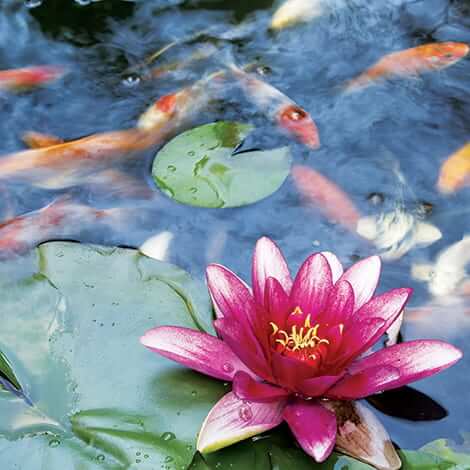Aquatic plants are a perfect addition to any pond, bringing color and function to keep your water garden balanced and beautiful. As any gardener knows, the first step in a successful garden is to plan what you want to plant. Below are a few points to consider when selecting plants for your pond.
- Number of Plants: Covering around half of your pond's surface area with plants will help reduce excess nutrients, control algae blooms, and provide cover for your fish. For example, in ponds up to 50 square feet, we recommend 6-12 floating plants, 2 bog plants, 5 submerged plants, and 1 water lily.
- Weather Hardiness: Climates are different throughout the nation, influencing the types of plants that can be grown in those areas. The USDA publishes a hardiness zone map to help determine which plants will likely survive your local climate. Many aquatic plants are perennials, so choosing ones from your hardiness zone will be key because they can best tolerate the year-round weather conditions.
- Sun or Shade: Plants are also categorized by which type of light they would like to receive (full sun, partial sun, partial shade, or full shade). Sensitive Plant prefers to lay out in the sun, but the Chameleon Plant likes to blend into the shade. Additionally, ponds with full sun exposure are more prone to algae growth, so add a few extra plants to help keep it shaded.
- Deep or Shallow: Some plants prefer deep water, whereas others like it shallow. Lilies and lotus prefer deeper water once established, but Blue Flag Iris and other bog plants only like to get their roots wet. Follow all planting directions when you receive new plants, as deep-water-loving varieties might prefer the shallows while they are getting started.
- Water Flow: Water flow rate is a factor that is often overlooked, but some plants love moving water while others require stillness. For example, hardy Dwarf Cattails can grow in streams, but lilies need a placid environment.
- Plan Ahead: Because pondkeeping is seasonal, some plants are unavailable later in the year. To ensure you get the ones you want, call us and pre-order them early in the calendar year. Our nursery will keep them for you and ship them when the weather is right.
Plant Care
When ordering your plants, it is ideal to get the planting materials you need at the same time. Use soil designed for water gardens and avoid using bagged potting mix or other lightweight soils as they will float and cloud the water. We recommend The Pond Guy Aquatic Planting Soil topped with The Pond Guy Aquatic Planting Media for luscious growth without the mess.
- Lilies and Lotuses: Best grown in pots, such as the Planting Kit for Water Lilies & Lotus. Fill your tub with our premium pond soil (75%). Position the bulb inside the soil with the growing tip pointed up. Top with Aquatic Planting Media (25%). Soak the soil and media, and then place the container in the pond so the growing tip is in 3-6" of water. Once the leaves reach the surface, you can place the pot in a deeper area of your pond.
- Bog Plants: Best sown in soft-sided containers, like those in our Bog Plant Planting Kits. Fill planters with 75% planting soil. Create a pocket a few inches deep in the soil and deposit your plants. Next, cover the plant base with Aquatic Plant Media, filling the planter to the top. Soak plants before placing them in the pond to keep the media settled. Plant Bags are ideal for the edges of your pond, especially as they mold to uneven surfaces and irregular shapes. Bog plants will also thrive in a Floating Island Planter.
- Submerged Plants: May free-float throughout your water features. They can also be grown in Plant Bags or tied to a weight and dropped into the pond.
- Floating Plants: Simply place them in the water, and they will freely float and absorb nutrients through their root systems.
Remember to boost your pond plants with CrystalClear Thrive Fertilizer to give them the nutrients they need for beautiful blooms!
Do you have more aquatic planting questions?
Give us a call at 866-POND-HELP (766-3435) or check out some more helpful articles linked below:
How to Plant Water Lilies
Adding Aquatic Plants
How to Divide Pond Plants
Last Updated: February 15, 2024
